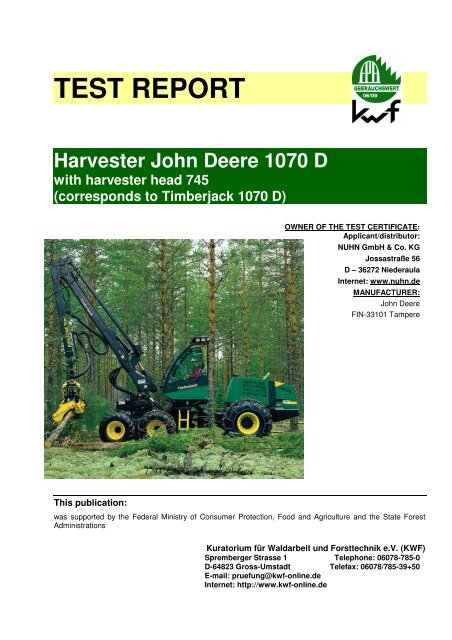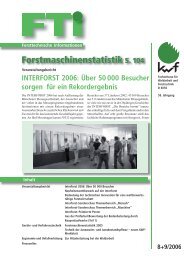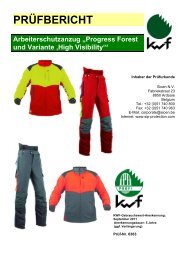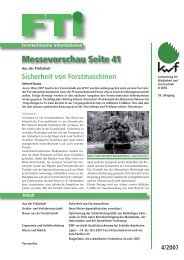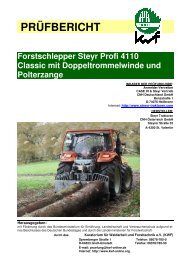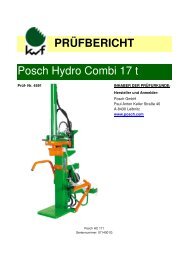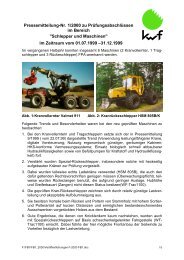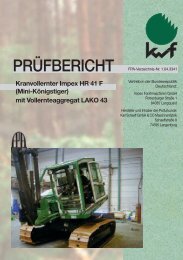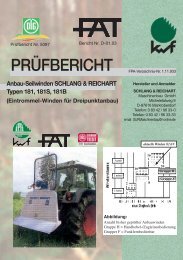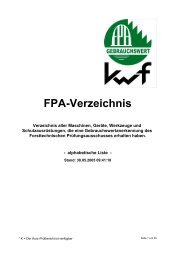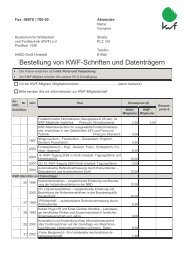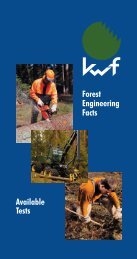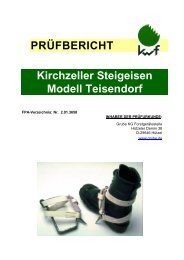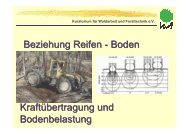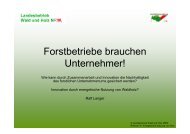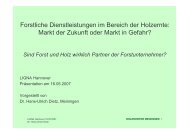TEST REPORT
TEST REPORT
TEST REPORT
You also want an ePaper? Increase the reach of your titles
YUMPU automatically turns print PDFs into web optimized ePapers that Google loves.
<strong>TEST</strong> <strong>REPORT</strong><br />
Harvester John Deere 1070 D<br />
with harvester head 745<br />
(corresponds to Timberjack 1070 D)<br />
OWNER OF THE <strong>TEST</strong> CERTIFICATE:<br />
Applicant/distributor:<br />
NUHN GmbH & Co. KG<br />
Jossastraße 56<br />
D – 36272 Niederaula<br />
Internet: www.nuhn.de<br />
MANUFACTURER:<br />
John Deere<br />
FIN-33101 Tampere<br />
This publication:<br />
was supported by the Federal Ministry of Consumer Protection, Food and Agriculture and the State Forest<br />
Administrations<br />
Kuratorium für Waldarbeit und Forsttechnik e.V. (KWF)<br />
Spremberger Strasse 1 Telephone: 06078-785-0<br />
D-64823 Gross-Umstadt Telefax: 06078/785-39+50<br />
E-mail: pruefung@kwf-online.de<br />
Internet: http://www.kwf-online.de
Harvester John Deere 1070 D<br />
with harvester head 745<br />
Beurteilung – kurz gefasst<br />
Test item Test results Evaluation<br />
Harvester class 2<br />
Chief application field<br />
Driving performance<br />
70 kW < Engine power < 140 kW<br />
Clearing coniferous forest in easy to difficult terrain, average chest height diameter of<br />
trunks 14-25 cm; maximum trunk diameter 50 cm<br />
Driving speed Relocating 19.5 km/h + +<br />
Off-road capability Off-road capability coefficient: 0.75 o<br />
Transport Overall height per axle 3.6 m + +<br />
Felling and processing<br />
Crane control Electronic transmission system Timbermatic 300<br />
7 programmable operator settings<br />
Crane construction<br />
Net lifting power at maximum reach 0.0 kN, at 4 m reach 16.2 kN<br />
minimum reach 9,7 m, tiltable<br />
Stability Lateral stability when loaded at maximum reach is provided (with water) o<br />
Delimbing Feed speed 3.8 m/s, feed force 11.0 kN +<br />
Measuring and control system Timberjack Timbermatic 300<br />
Ergonomics<br />
Noise L eq = 62 dB(A) + +<br />
Vibration K = 10.9 o<br />
good<br />
good<br />
+ +<br />
o<br />
good<br />
Cab design<br />
Very well arranged display and control elements comfortable and large<br />
cab<br />
+ +<br />
Visibility High convex windscreen, narrow cab stays +<br />
Workspace illumination Good and glare-free illumination +<br />
Arbeitsschutz<br />
DPLF work safety test<br />
Umweltverträglichkeit<br />
good<br />
Ground impact 79 ground impact points -<br />
Operational fluids<br />
Rapid bio-degradable hydraulic fluid, 8 hazardous substances with water hazard<br />
class > 1 unknown<br />
Fuel consumption 11 l/ operating hour (spec. consumption unknown.) n.e.<br />
Leak reduction design<br />
measures<br />
Vacuum pump, quick release coupling for hydraulic fluid filling and<br />
draining; hydraulic fill pump<br />
Emissions unknown - -<br />
o<br />
+ +<br />
Economy<br />
Cost (without wages)<br />
Maintenance (incl. refuelling)<br />
Power<br />
Besonderheiten<br />
According to calculation scheme 86 Euro/ operating hour<br />
(based on 1500 operating hours/year)<br />
approx ¾ hour daily; approx. 1.5 hours weekly<br />
Within power limits for this harvester class<br />
Balanced bogie reduces pitching<br />
+ + = very good; + = good; o = satisfactory; - adequate; - - = inadequate (*Manufacturers declaration)<br />
2/9
Short description<br />
Figure 1: Machine sketch and crane area diagram<br />
• Front and rear bogie in closed frame construction, rear bogie reinforced ladder-type chassis frame, struts partially<br />
closed<br />
• Nearly centrally positioned articulated joint and rear interleaving joint with disc brake, different track width front and<br />
rear<br />
• hydrostatic transmission with speed level control, successive 2-step group transmission; temporary front bogie drive<br />
• Test tyres: front: Trelleborg 710/40-22,5 151 A 8<br />
rear: Trelleborg LS-2 620/55-30,5 158 A 8<br />
• Load sensitive hydraulic system with permanent pressure<br />
• Electronic transmission system for hydraulics, crane functions and machine control (Timberjack TMC together with<br />
Timbermatic 300)<br />
• Total weight (incl. water):<br />
• Transport height for flat bed trailer:<br />
for road:<br />
• Width (maximum):<br />
• Turning circle diameter:<br />
15140 kg<br />
3555 mm<br />
3555 mm<br />
2830 mm<br />
14100 mm<br />
• Chief application field<br />
Depending on the conditions of the terrain (micro-relief, obstructions, snow) the machine cannot be operated above a<br />
gradient of about 35%. The application field is also determined by the maximum felling diameter (55 cm) and the<br />
maximum delimbing diameter of 40 cm. The machine is capable of processing long wood as well as hardwood.<br />
Min.<br />
Akt.<br />
Max.<br />
Gross lifting moment (kNm)<br />
72,0<br />
143,0<br />
200,0<br />
0 50 100 150 200 250<br />
Figure 2: Comparison between the current test machine and the minimum and<br />
maximum values from the 12 machines tested to date in the same engine power class<br />
3/9
Engine<br />
Liquid-cooled, 4-stroke, 6 cylinder diesel engine JD 6081 HTJ 04 with direct injection and common-rail water-cooled turbo<br />
charger and air-cooled intercooling, rapeseed oil methyl ester -capable, if fuel complies with fuel quality DIN 51606 or<br />
similar standards<br />
Capacity 6788 cm³<br />
Power Nominal engine speed 1900 1/min 136 kW<br />
max. torque Nominal engine speed 1900 1/min 684 Nm<br />
max. torque Working engine speed 1400 1/min 779 Nm<br />
Torque increase 14 %<br />
Average fuel consumption under working conditions 11 l/MAS<br />
Fuel tank capacity 300 l<br />
rapeseed oil methyl ester or vegetable oil<br />
If fuel complies with manufacturer specifications<br />
capability<br />
Min.<br />
Akt.<br />
Max.<br />
Engine power (kW)<br />
83,0<br />
136,0<br />
130,0<br />
0 20 40 60 80 100 120 140 160<br />
Figure 3: Comparison between the current test machine and the minimum and<br />
maximum values from the 12 machines tested to date in the same engine power class.<br />
Min.<br />
Akt.<br />
Max.<br />
Fuel consumption (l/operating hour)<br />
7,5<br />
11,0<br />
18,0<br />
0 5 10 15 20<br />
Figure 4: Comparison between the current test machine and the minimum and<br />
maximum values from the 12 machines tested to date in the same engine power class.<br />
Work circuit hydraulics<br />
Load sensing hydraulic system with permanent pressure; adjustable swash plate piston pump; system volume 200 l<br />
Hydraulic pump<br />
Bosch Rexroth A 11 VO<br />
Capacity at nominal engine speed (1400 rpm) 0 – 203 l/min<br />
Power output<br />
(installed power)<br />
at 1900 rpm<br />
at 1400 rpm<br />
Hydraulic pressure maximum 28 MPa<br />
Hydraulic tank capacity 170 l<br />
129<br />
95<br />
kW<br />
kW<br />
4/9
Drive circuit hydraulics<br />
Electronically controlled hydrostatic transmission<br />
Hydraulic pump Bosch Rexroth A4VG 90<br />
Capacity<br />
Power output<br />
(installed power)<br />
at nominal engine speed<br />
(1900 rpm)<br />
at 1900 rpm<br />
at 1400 rpm<br />
0 – 171 l/min<br />
Hydraulic pressure maximum 45.0 MPa<br />
Hydraulic engine<br />
Bosch Rexroth A6VM<br />
Absorption volume 0 - 160 cm³/U<br />
128<br />
95<br />
kW<br />
kW<br />
Crane<br />
TJ 180 97; mounted on front bogie; slewing mechanism centrally mounted between front axle; slewing mechanism<br />
driven by 4 pressure cylinders and 2 racks; parallel crane with boom and jib with a very low column and single-step<br />
telescope<br />
Gross lifting torque 143 Nm<br />
Tilt angle front/back/left/right 16.5 / 16.5 / – / – °<br />
Maximum reach (incl.1-step telescope) 9.7 m<br />
Net lifting power (maximum reach/4m reach) 0 / 16 kN<br />
Telescope pulling power 12.0 kN<br />
Slewing torque (left/right) 35.2 kNm<br />
Turning area (left/right) 226<br />
Required amount of hydraulic fluid * unknown l/min<br />
* Manufacturers declaration<br />
°<br />
Min.<br />
Akt.<br />
Max.<br />
Maximum crane range (m)<br />
8,8<br />
9,7<br />
10,3<br />
0 2 4 6 8 10 12<br />
Figure 5: Comparison between the current test machine and the minimum and<br />
maximum values from the 12 machines tested to date in the same engine power class<br />
Measuring system evaluated according to the KWF-specification sheet<br />
Timbermatic 300<br />
Hardware<br />
Display<br />
Input device<br />
Colour VGA graphic display in work direction, mounted directly in front of operator (may obstruct view<br />
downhill), manual brightness and contrast control, excellent readability<br />
Keypad near joysticks (special keys for species and qualities), PC keyboard slides under monitor,<br />
trackball for controlling cursor; well proportioned and arranged for easy operation<br />
Printer Ink jet printer with single sheet printout (DIN A4)<br />
Control prints<br />
Data completeness<br />
Clarity of data labelling<br />
HKS-conformity<br />
Requirements of KWF-specification sheet<br />
Operability and performance of system<br />
Calibration and control of electronic callipers/manual<br />
Precision of measurement<br />
Measurement stability<br />
Overall evaluation:<br />
5/9<br />
yes<br />
satisfactory<br />
fulfilled<br />
Very good/satisfactory<br />
Very good<br />
Very good<br />
good
Harvester head<br />
745<br />
Overall mass<br />
871 kg<br />
(with/without rotator and swing brake)*<br />
required pump capacity* unknown l/min<br />
Cutting length(available) 550 mm<br />
Chain speed 40 m/s<br />
Saw chain lubricating oil consumption* 0.7* l/ operating hour<br />
Saw chain lubricating oil tank volume 5 l<br />
Feed roller diameter 395/238 mm<br />
Guide length 750 mm<br />
Delimbing diameter 400 mm<br />
max. felling diameter 550 mm<br />
Arm function<br />
2 encircling delimbing knives at top and 1 at the bottom of the unit; supported by feed<br />
rollers in necessary<br />
* Manufacturers declaration<br />
1 1 fixed top v-shaped delimbing knife<br />
2 2 top, encircling, moving delimbing knives attached to basic<br />
frame, diameter-dependant contact pressure<br />
3 4 hydrostatically driven feed rollers (2 swivelling steel rollers<br />
with elliptical spikes, 2 fixed profile rollers)<br />
4 1 lower movable delimbing knife<br />
5 Felling unit with electro-hydraulically operated and driven<br />
chainsaw, diameter-dependant cut control<br />
Figure 6 harvester head<br />
6 Spring-loaded length measuring wheel<br />
7 Diameter measurement by two angle gauges connected to the<br />
upper delimbing knives<br />
8 Manual chain tensioner<br />
Min.<br />
Akt.<br />
Max.<br />
Maximum felling diameter (cm)<br />
35,0<br />
55,0<br />
60,0<br />
0 10 20 30 40 50 60 70<br />
Figure 7: Comparison between the current test machine and the minimum and<br />
maximum values from the 12 machines tested to date in the same engine power class.<br />
6/9
Spare parts supply, manuals and service<br />
good<br />
Maintenance effort<br />
Maintenance scope<br />
Operator manual<br />
Spare parts list<br />
Training<br />
Satisfactory, maintenance is generally easy, central lubrication of the boom facilitates crane<br />
maintenance; front lower maintenance covers must be opened with utmost caution<br />
According to schedule and need; time required for daily maintenance (incl. operational fluid<br />
refilling) is about ¾ hour, für weekly maintenance requires about 1.5 hours<br />
Very well structured, clear and easy-to-read instructions<br />
Profusely illustrated and well-structured; all parts are easily found<br />
Training provided at delivery and additional training is available upon request; 2 days on the<br />
machine and 1 day additional training<br />
Cab<br />
Comfortable ROPS-, FOPS- and OPS – tested, vibration dampened, large safety cab with large front screen; very<br />
organized design<br />
Operator seat Heated highly adjustable operator seat KAB 56with air suspension, swivels through 90°;<br />
electromechanical brakes, tilts laterally through 12°; includes pneumatic lumbar support<br />
Cab size and design<br />
Cab climate<br />
Control elements<br />
Comments / Evaluation<br />
Bright safety cab with plenty of free space; high front screen;<br />
well organized and useful design; good workmanship;<br />
Complies with<br />
standard<br />
Heating and manual climate control with 3-step audible ventilator, recirculation switch<br />
and pre-warming system<br />
useful and well organized arrangement, all elements are well<br />
labelled and easy to reach, some functions can be<br />
distinguished by touch<br />
yes<br />
yes<br />
Levelling<br />
Work field illumination<br />
Visibility<br />
Seat with lateral tilting capability<br />
The large number of halogen working lamps and the 4 crane lamps provide good<br />
illumination of the work field, however when compared to xenon lamps the illumination is<br />
only satisfactory<br />
Large windows in the cab, narrow chassis stays and high front windscreen provide good<br />
visibility of the tree crowns as well as the front wheels; some obstruction by the crane<br />
column, relatively small sun screen provides inadequate glare protection<br />
Noise low Noise level 61.9 dB(A) yes<br />
Vibration K-Wert = 10.9<br />
According to current state of knowledge, exposing the operator to these vibration levels<br />
for a period of 8 hours (shift) is not expected to have detrimental health effects.<br />
Storage space on the<br />
machine<br />
Storage space in the cab<br />
Adequate, 185 litres; 1 storage space for tools in the front of the machine, 2 storage<br />
spaces in the rear, 1 additional small storage space near the access ladder<br />
a special storage space is provided for the operating manual and first-aid kit; additional<br />
storage space for a small cool-box and personal belongings; storage space for cutting<br />
bars under the cab floor<br />
7/9
Machine costs and calculation basis<br />
Price for tested version 288000 €<br />
Workload operating hours/year 1500 2000 3000 Total service life [operating hours] 10000<br />
Recovery period (years) 6,7 5 3,3 Repair cost factor 1.0<br />
€/<br />
operating<br />
hours<br />
(rounded)<br />
€/<br />
operating<br />
hours<br />
(rounded)<br />
€/<br />
operating<br />
hours<br />
(rounded)<br />
Fuel + lubricants in €/ operating hours 14.30<br />
Recovery 28.80 28.80 28.80 Price for diesel [€/l] 1.0<br />
Repair and maintenance 28.80 28.80 28.80 Interest rate [%] 8.0<br />
Fuel and lubricants 14.30 14.30 14.30 Transport costs [€]/1000 operating<br />
hours<br />
4500<br />
Interest rate 7.70 5.80 3.80 Additional costs [€] 7500<br />
Transport, driving 4.50 4.50 4.50 Technical work productivity::<br />
Others 5.00 3.80 2.50 9.6 cubic meters/operating hour<br />
Machine costs 89.10 86.00 82.70 Within the performance range for harvester class 2<br />
Additional equipment (not tested)<br />
• Alternative harvester head with cutting diameters: H 732 (400 mm), H 742 (470 mm), H 752 (550 mm), H 754<br />
(550 mm)<br />
• Swivelling and self-levelling cab<br />
• Additional crane with different reach: TJ 180 H 83 (8.3 m), TJ 180 H 110 (11.0 m)<br />
• Alternative 600 or 700 tyre size (both axles)<br />
• Xenon lamps<br />
• Fire extinguishing system<br />
• Stump treatment system<br />
• Automatic crane levelling<br />
• Software Timberoffice<br />
• GPS-equipment<br />
• Rear drive acoustic alarm<br />
Test<br />
Note: Since this machine is no longer in production, the following additional requirements cannot be<br />
integrated by the manufacturer. However the manufacturer has incorporated the requirements and<br />
recommendations into the design of the follow-up series of the machine<br />
Remaining requirements:<br />
The specifications label on the machine includes values for the axle loads at the permitted total weight and the permitted<br />
rear axle load that are lower than the measured values. This information must be amended.<br />
The door contact switch is easily bridged; the design of the switch should be changed to reduce the risk of manipulation.<br />
The handgrips near the cab access door should be altered so that they can be used without the need to change grip<br />
position during ascent.<br />
The access step is too narrow and does not provide sufficient clearance; the step is also mounted too high; the step<br />
should be modified accordingly.<br />
There is a risk of injury due to crushing between the cab floor and the seat inclination adjustment (lateral tilt); this must be<br />
changed.<br />
The lower front and lower middle maintenance covers have no hinges. The opening width is unrestricted. Opening the<br />
covers can be very dangerous. The covers must be designed according to current applicable safety requirements.<br />
8/9
The positive poles of the battery are insufficiently protected against shorting. The positive poles must be designed<br />
according to current safety standards.<br />
When working with conveyor belts, high loads may cause damage to the access to the cab; the design of the access<br />
should be modified to prevent such damage.<br />
The manual lacks guidelines concerning the correct use of the machine. These must be included.<br />
The operating manual must include values for whole-body and hand-arm vibration.<br />
Recommendations:<br />
The air filter is difficult to remove when engine hood is completely opened; the positioning of the air filter should be<br />
changed accordingly.<br />
The cab is insufficiently protected against sun – this should be improved.<br />
The space between cab and crane column is not covered – flammable debris can accumulate here. This should be<br />
improved.<br />
The mounting of both swivelling feed engines of the harvester head are inadequate and should be improved.<br />
There is a danger of chafing hydraulic hoses in the harvester head; this should be improved.<br />
The operation of the manual lever steering is not immediately apparent. A more useful construction should be developed.<br />
The following documents were not available:<br />
Current machine documents were not available at the time of the test and should be supplied at a later stage.<br />
Test institute<br />
Kuratorium für Waldarbeit und Forsttechnik, Groß-Umstadt<br />
Authors<br />
Dr. Günther Weise, Lars Nick, Dr. Andreas Forbrig, KWF, Groß-Umstadt<br />
KWF-Utility-Test<br />
Test no. 4013, valid until June 30, 2014<br />
According to the test regulations, the applicant is entitled to display the test mark on machines of this<br />
type and to use the certification for advertising purposes.<br />
9/9


